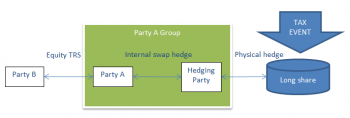Hedging Party - Equity Derivatives Provision: Difference between revisions
Amwelladmin (talk | contribs) No edit summary |
Amwelladmin (talk | contribs) No edit summary |
||
| (8 intermediate revisions by the same user not shown) | |||
| Line 1: | Line 1: | ||
{{ | {{eqdmanual|12.9(a)(ix)}} | ||
Latest revision as of 13:46, 1 October 2023
Overview
Compare Hedging Party, Determining Party and Calculation Agent — indeed, see a special article we have made which does exactly that.
Summary

Relevant in the context of Additional Disruption Events and hedging disruption, the Hedging Party will be the entity actually carrying out the hedging activity, if it isn’t the party to the ISDA Master Agreement itself. If no Hedging Party is specified, it defaults to the parties themselves.
Note also the related concept of the Determining Party, who is the person calculating the replacement cost of the Transaction following an Extraordinary Event (e.g. termination following a Hedging Disruption, Change in Law or Increased Cost of Hedging).
In this case there will be a string of intermediate hedging contracts — usually derivatives — but these may not behave in exactly the way that a real underlier would (in terms of market disruption, tax events, liquidity etc). and what the Equity Derivatives Definitions are meant to do is pass on the risk associated with the actual underlier.
So for example in the example pictured, Party A provide exposure to client, hedges that with a equity TRS to Hedging Party, which goes long the physical share. Now the Hedging Party, not Party A, has the risk of the physical assets. If there is a market disruption, or a tax event on the physical hedge this is reflected in the price that Hedging Party will have to pay to Party A, but it isn’t a market disruption or tax event directly on Party A itself (and in fact might not be – Party A might be domiciled in a jurisdiction benefitting from a different tax treaty with the jurisdiction of the underlier, for example). So in this case we need to reference the position as held by a person other than the counterparty to the swap.
Note also that “Non-Hedging Party” definition somewhat assumes that the Hedging Party will indeed be the actual counterparty to the Transaction.
Premium content
Here the free bit runs out. Subscribers click 👉 here. New readers sign up 👉 here and, for ½ a weekly 🍺 go full ninja about all these juicy topics 👇
|
- The JC’s famous Nutshell™ summary of this clause
See also
- Determining Party,
- Non-Hedging Party,
- Hedging Disruption,
- Increased Cost of Hedging,
- Loss of Stock Borrow,
- Increased Cost of Stock Borrow,
- Hedging Shares,
- Lending Party.